Peru is a great place to shop. But, among all the goodies we could bring home, textiles are the star. Peruvian weavers are noted for colorful goods, be they tapestries, smaller decorative pieces or the simplest things, like headbands. I was reminded of this in a big way during a spring 2025 return to the country.
Historic associations
But first, the background: Andean men and women have woven textiles for thousands of years. The Inca era was short, 1420-1532, but numerous cultures preceded it, and each was distinguished by specific weaving methods and unique patterns.
This was a string of cultures with no written languages, but Andean people used weaving to “write” about their worldviews, their systems of belief; in other words, textile designs became a kind of woven language.
The Andean khipu, essentially a cluster of strings covered with strategically placed knots, was an extension of that. The khipu (or quipu) was the Incas’ main record-keeping tool, but the Incas did not invent it.
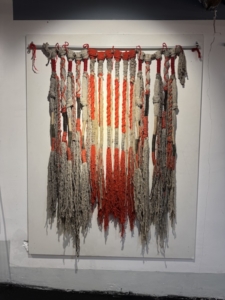
Artwork modeled on the historic Andean khipu (aka quipu), which used knots as a record-keeping system. This was seen in the Sulca Textile House Museum near Cusco.
Further, the Incas imposed a labor-based tax system, meaning residents paid taxes with the labor most valued by their overlords. For some, that meant weaving textiles and producing cloth.
Textile center
Fast forward to the 21st century: On my recent Peru trip, I traveled with journalists as a guest of the Inkaterra hotel group. We visited a textile center that straddles the Cusco-Pisac highway about 30-35 minutes from the heart of Cusco.
The textile complex, which boasts some seriously high-end goods, is home to a handful of textile businesses. We visited two.
• The Manos de la Comunidad is a commune of some 30 to 40 weavers.
The commune keeps animals (all the camelids — alpacas, guanacos, llamas and vicunas) on site for visitor viewing, and even for photos with the animals — well, there were no photos with the wild vicunas. Many of these species provide fleece for weaving.
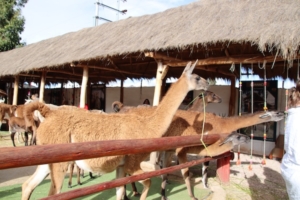
Guanacos greeting new arrivals at the Manos de la Comunidad, a weavers commune outside of Cusco.
We watched spinners and weavers, men and women, at their work. A host provided a short lecture about making dyes. For a further touristy touch, a few costumed musicians welcomed us. By this point, thoughts of Disneyland were traipsing across my mind.
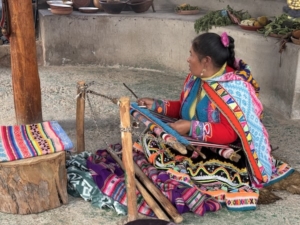
Above, a weaver at the Manos de la Comunidad commune, showing how it is done, for the benefit of tourists. Below, musicians at the commune.
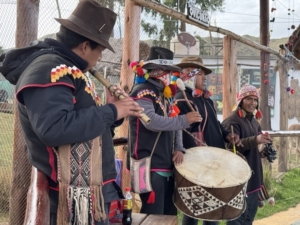
But, once I was in the showrooms, it became clear this was no chintzy tourist stop. Displays included countless woven items, generally wall hangings, but also rugs, scarves and masks. Many tapestry designs were inspired by or even outright copied from traditional patterns.
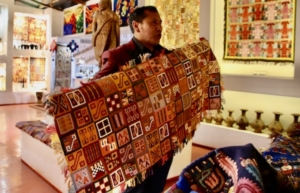
Above, on-site host at the Manos de la Comunidad displaying a handmade rug that features a traditional Inca design. Below, a tapestry, a modern take on old themes, hanging inside the commune showrooms.
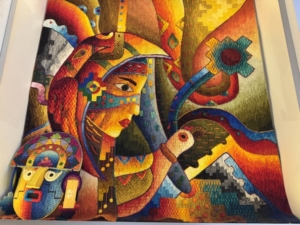
Then, there were the modern, even rather edgy, designs that nevertheless reflected precolonial influences. Their colors were vivid and the creativity eye popping.
• The Sulca Textile House Museum, created by the Sulca family, is across the highway from the commune.
Our guide said the Sulca business creates its products in Ayacucho while the Cusco site is a place for exhibiting and selling the goods.
The work is meant to preserve an old culture. The Sulca business uses traditional methods of production for its products, our guide said, and weavers often replicate precolonial designs. The museum displays both historical tapestries and some of Sulca’s own finest pieces.
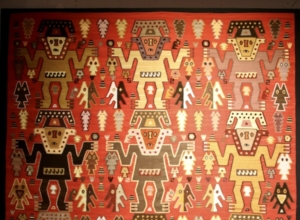
Above and below, weavings that copy precolonial patterns, seen inside the Sulca Textile House Museum. It seems the Inca squares are everywhere.
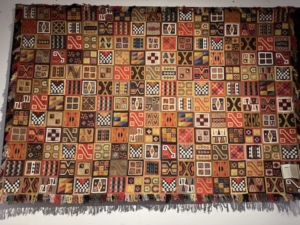
We watched and photographed three women demonstrating backstrap weaving, but Sulca’s large demo looms were silent when we visited. Corrals accommodate camelids here, as well.
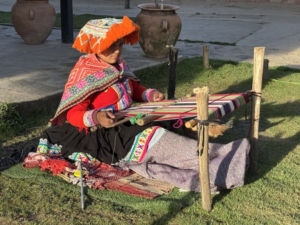
Backstrap weaving on the grounds of the Sulca Textile House Museum.
For me, the textiles made for a great show, but I did not buy. I already have two Peruvian tapestries, and my walls cannot take more. Other shopping options included wool clothing — a fellow traveler bought coats of baby alpaca fleece.
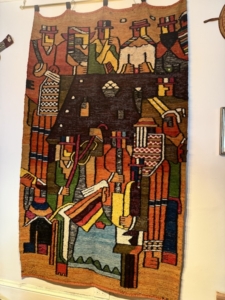
One of my Peruvian tapestries, called “The Banquet.”
Machu Picchu
Other shopping options may be easier to access — depending on one’s itinerary.
During this recent Peru visit, I spent a day in Machu Picchu Pueblo, the small tourist town (population 6,000) that is the starting point for all the up-the-mountainside, down-the-mountainside bus trips to and from the Machu Picchu archaeological site.
I see that, in an earlier diary, I had dismissed the settlement as barely worth noting. But I don’t dismiss it anymore.
Machu Picchu Pueblo’s public spaces — a main square with the de rigueur church and city hall, plus promenades on either side of the Aguas Calientes River that slices through the middle — were a pleasant surprise. And I relished buying small gifts in a large outdoor artisans market created just for out-of-towners like me.
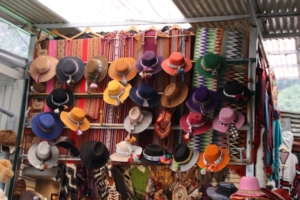
Above, a small section of the sizeable artisans market next to the train station in Machu Picchu Pueblo. This merchant emphasized woven goods and hats. Below, the main square in Machu Picchu Pueblo.
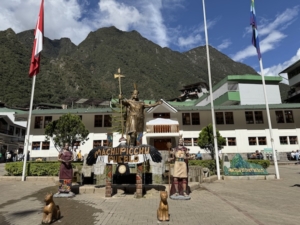
Pisac, Ollantaytambo
In 2011, I had access to colorful rows of stalls in Pisac, still one of Peru’s better-known market towns. It is in the Sacred Valley of the Incas, meaning in the valley of the Urubamba River. It’s billed as a market town where locals come to buy, sell and barter goods, but the tourist element was quite big here.
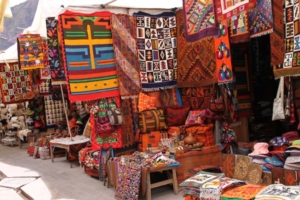
Above and below, a wide array of woven and other goods on offer to visiting shoppers in Pisac, Peru’s popular market town (2011 photos).
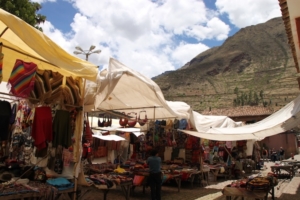
Ditto for the rows of stalls at Ollantaytambo. Just FYI, while the shopping opportunity at Ollantaytambo is substantial, the key touristic reason for a visit is to view the town’s Inca-era Temple of the Sun and Terrace of the Ten Niches, situated on mountainsides and overlooking the market and the rest of the town. Oh, and there are terraces all over the mountains, too.
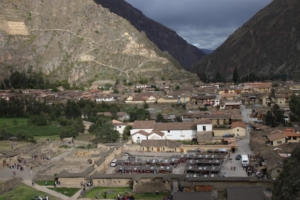
Ollantaytambo, the town, its market (roofs seen at center foreground) and the valley where it sits, as viewed from mountainside terraces. The Ten Niches are barely visible in the upper lefthand corner (2011 photo).
One final thing to share, mainly because it amused me so much: In 2025, while in Cusco, local merchants were quite eager to do business, sometimes on the street rather than in shops. One woman, with goods draped over her arm, walked behind me, urging me to have a look. She advised that she would accept American Express.
For more information about Peru, we offer at BestTripChoices.com the following, under the headline, Land of Machu Picchu at https://besttripchoices.com/peru/
This blog and its photos are by Nadine Godwin, BestTripChoices.com editorial director and contributor to the trade newspaper, Travel Weekly. She also is the author of “Travia: The Ultimate Book of Travel Trivia.”
